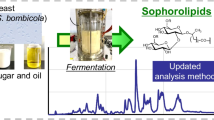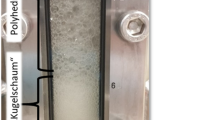Abstract
Serrawettin W1 produced by Serratia marcescens is a surface-active exolipid resulting in a lot foam formation during the 2,3-butanediol (2,3-BD) fermentation process. In order to avoid excessive addition of antifoam agent and microbial contamination, S. marcescens mutants deficient in serrawettin W1 formation were successfully constructed through insertional inactivation of the swrW gene coding for serrawettin W1 synthase. The shake flask and batch experiments suggested that disruption of the swrW gene led to significant reduction of the foam formation and improved 2,3-BD production a little. Ultimately, fed-batch culturing of the mutant afforded a maximum 2,3-BD concentration of 152 g l−1 with a productivity of 2.67 g l−1 h−1 and a yield of 92.6% at 57 h.




Similar content being viewed by others
References
Bahadur K, Dube JN (1958) Study of 2,3-butanediol formation by Serratia marcescens. Arch Microbiol 32(1):16–19
Celińska E, Grajek W (2009) Biotechnological production of 2,3-butanediol—current state and prospects. Biotechnol Adv 27(6):715–725
de Lorenzo V, Herrero M, Jakubzik U, Timmis K (1990) Mini-Tn5 transposon derivatives for insertion mutagenesis, promoter probing, and chromosomal insertion of cloned DNA in gram-negative eubacteria. J Bacteriol 172(11):6568–6572
de Mas C, Jansen NB, Tsao GT (1987) Production of optically active 2,3-butanediol by Bacillus polymyxa. Biotechnol Bioeng 31:366–377
Garg SK, Jain A (1995) Fermentative production of 2,3-butanediol: a review. Bioresource Technol 51:103–109
Ji XJ, Huang H, Zhu JG, Ren ZL, Nie ZK, Du J, Li S (2009) Engineering Klebsiella oxytoca for efficient 2,3-butanediol production through insertional inactivation of acetaldehyde dehydrogenase gene. Appl Microbiol Biotechnol 85(6):1751–1758
Li H, Tanikawa T, Sato Y, Nakagawa Y, Matsuyama T (2005) Serratia marcescens gene required for surfactant serrawettin W1 production encodes putative aminolipid synthetase belonging to nonribosomal peptide synthetase family. Microbiol Immnol 49(4):303–310
Lindum PW, Anthoni U, Christophersen C, Eberl L, Molin S, Givskov M (1998) N-Acyl-l-homoserine lactone autoinducers control production of an extracellular lipopeptide biosurfactant required for swarming motility of Serratia liquefaciens MG1. J Bacteriol 180:6384–6388
Matsuyama T, Sogawa M, Nakagawa Y (1989) Fractal spreading growth of Serratia marcescens which produces surface active exolipids. FEMS Microbiol Lett 61:243–246
Matsuyama T, Kaneda K, Nakagawa Y, Hara-Hotta H, Yano I (1992) A novel extracellular cyclic lipopeptide which promotes flagellum-dependent and independent spreading growth of Serratia marcescens. J Bacteriol 174:1769–1776
Phale PS, Savithri HS, Appaji Rao N, Vaidyanathan CS (1995) Production of biosurfactant Biosur-Pm by Pseudomonas maltophila CSV89: characterization and role in hydrocarbon uptake. Arch Microbiol 163:424–431
Van Haveren J, Scott EL, Sanders J (2007) Bulk chemicals from biomass. Biofuel Bioprod Bior 2:41–57
Van Houdt R, Moons P, Hueso Buj M, Michiels CW (2006) N-Acyl-l-homoserine lactone quorum sensing controls butanediol fermentation in Serratia plymuthica RVH1 and Serratia marcescens MG1. J Bacteriol 188(12):4570–4572
Xiu ZL, Zeng AP (2008) Present state and perspective of downstream processing of biologically produced 1,3-propanediol and 2,3-butanediol. Appl Microbiol Biotechnol 78:917–926
Yu EKC, Saddler JN (1983) Fed-batch approach to production of 2,3-butanediol by Klebsiella pneumoniae grown on high substrate concentrations. Appl Environ Microbiol 46:630–635
Zhang LY, Yang YL, Sun JA, Shen YL, Wei DZ, Zhu JW, Chu J (2010) Microbial production of 2,3-butanediol by a mutagenized strain of Serratia marcescens H30. Bioresource Technol 101:1961–1967
Acknowledgments
This work was supported by the Chinese National Program for High Technology and Development (863 Program) (No. 2006AA02Z243), Shanghai Leading Academic Discipline Project (Project B505), and State Key Laboratory special fund (No. 2060204).
Author information
Authors and Affiliations
Corresponding authors
Rights and permissions
About this article
Cite this article
Zhang, L., Sun, J., Hao, Y. et al. Microbial production of 2,3-butanediol by a surfactant (serrawettin)-deficient mutant of Serratia marcescens H30. J Ind Microbiol Biotechnol 37, 857–862 (2010). https://doi.org/10.1007/s10295-010-0733-6
Received:
Accepted:
Published:
Issue Date:
DOI: https://doi.org/10.1007/s10295-010-0733-6




